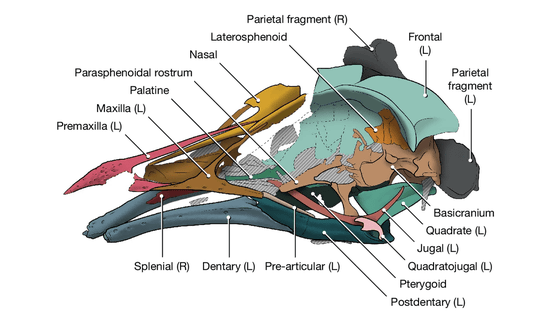Brain reconstructed from skull fossil of 80-million-year-old bird 'Navaornis hestiae' - could provide clues to understanding bird brain evolution?

A research team from Cambridge University and the Natural History Museum of Los Angeles County has successfully reconstructed the brain of the 80 million year old bird 'Navaornis hestiae' fossil discovered in Brazil in 2016, using 3D scanning. This suggests that Navaornis had a larger cerebrum than Archaeopteryx and had high cognitive abilities.
Cretaceous bird from Brazil informs the evolution of the avian skull and brain | Nature

Bird brain from the age of dinosaurs reveals roots of avian intelligence
'One of a kind' fossil from the age of dinosaurs reveals roots of bird intelligence | Natural History Museum
https://www.nhm.ac.uk/discover/news/2024/november/fossil-from-the-age-of-dinosaurs-reveals-roots-of-bird-intelligence.html
Rosetta Stone of Bird Brain Evolution | #CambridgeResearch - YouTube
The fossil was discovered in 2016 by William Nava, director of the Marilia Paleontological Museum in the state of São Paulo, Brazil, in an area called Presidente Prudente, close to the museum.

The bird, about the size of a starling, was extremely well preserved, with the skull almost completely preserved, which is unusual for a bird fossil. The bird was named 'Navaornis hestiae' after Director Nava.
A team of researchers from the University of Cambridge and the Natural History Museum of Los Angeles County used advanced micro-CT scanning technology to digitize Nabaornis' skull and create a 3D reconstruction of its brain.

The reconstruction data suggest that Nabaornis had a larger cerebrum and greater cognitive abilities than Archaeopteryx, but that areas such as the cerebellum were less developed and it probably did not yet have the complex flight control mechanisms of modern birds.
Until now, there has been no clue as to the evolutionary process that took place between Archaeopteryx and modern birds, but information on Nabaornis, whose brain structure is somewhere between those of Archaeopteryx and modern birds, is likely to provide a major clue to understanding how bird brains evolved.
Dr Guillermo Navaron, from the University of Cambridge's School of Earth Sciences, who was involved in the study, said: 'The Nabaornis fossil is unique and I have been in awe of it from the moment I first saw it to the moment we were able to reconstruct the skull and brain and see its full structure.'
Professor Daniel Field, from the University of Cambridge's School of Earth Sciences, said: 'Modern birds have some of the most sophisticated cognitive abilities in the animal kingdom, rivalling those of mammals. But scientists have struggled to understand how and when birds' unique brains and incredible intelligence evolved - which is exactly what fossils like Nabaornis have been waiting for.'
According to the research team, the skull of Nabaornis resembles that of a pigeon or a starling, but on closer inspection it becomes clear that it is a member of the Enantiornithidae family, which is named for 'reverse birds.'
Enantiornithines is a bird that branched off from modern birds more than 130 million years ago, and is thought to have had the ability to fly like modern birds, but it is not known how it controlled flight.
The research team believes that while this discovery is an important breakthrough, it is only the first step in understanding the evolution of bird intelligence. They say that if they can unravel how Nabaornis interacted with its environment, they may be able to find answers to questions about the evolution of bird cognition.
Related Posts:







